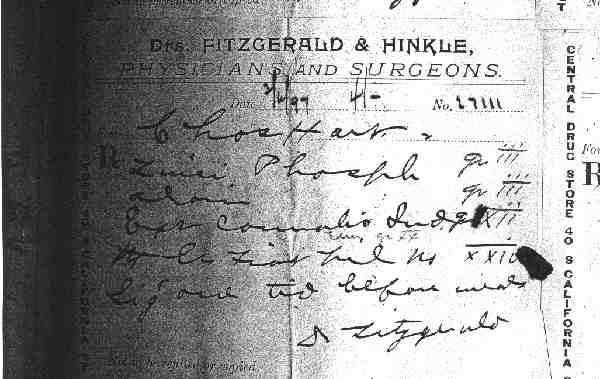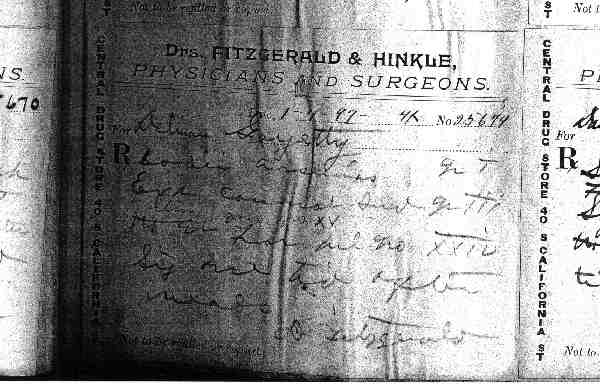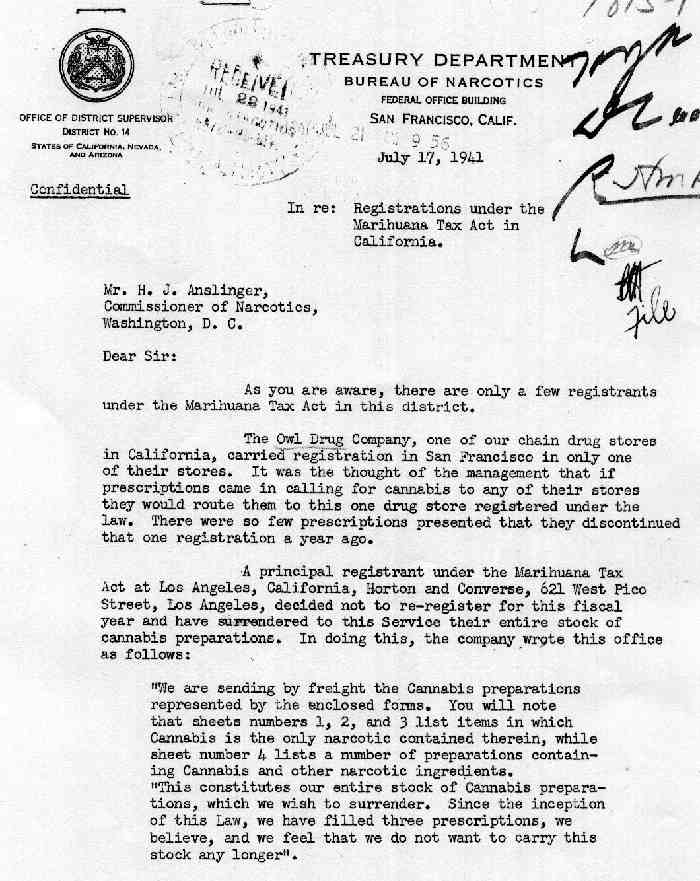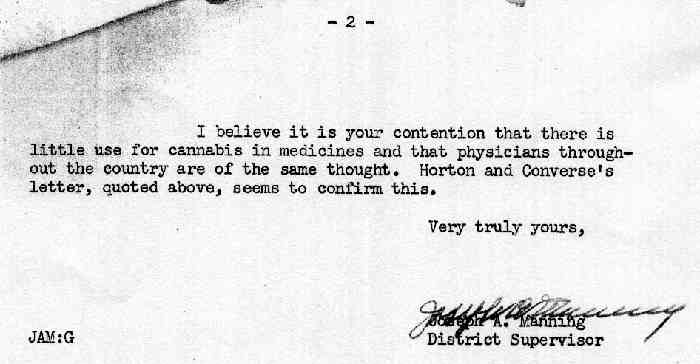
|
 |

|
|---|
PAGE 4
CALIFORNIA PRESCRIPTIONS:
Although California was among the first States in the Union to re-legalize the use of Medical Cannabis. It also bears the unfortunate distinction of being the first State in the Union to have originally outlawed its use in 1913. Because of this and other factors, many mistakenly believe that there was never any medical use of Medical Cannabis in the State; and thus no sense in looking for old medical prescriptions from there. However, as can be seen by these photocopies (courtesy of The Haggin Museum, Stockton, Ca.), Cannabis was indeed in medical use and doctors were writing prescriptions for Cannabis. In fact [law or no law] Cannabis was still to be found in California Drug Stores up until the 1940's.


The following is an internal D.E.A. (then known as the Bureau of Narcotics) memo. It clearly shows that Medical Cannabis WAS available in California drugstores in the 1940’s.


TREASURY DEPARTMENT
BUREAU OF NARCOTICS
FEDERAL OFFICE BUILDING
SAN FRANCISCO, CALIF.
July 17, 1941
OFFICE OF DISTRICT SUPERVISOR
DISTRICT No. 14
STATES OF CALIFORNIA, NEVADA, AND ARIZONA
In re: Registrations under the Marihuana Tax Act in California.
Mr. H. J. Anslinger,
Commissioner of Narcotics,
Washington, D.C.
Dear Sir:
As you are aware, there are only a few registrants under the Marihuana Tax Act in this district.
The Owl Drug Company, one of our chain drug stores in California, carried registration in San Francisco in only one of their stores. It was the thought of the management that if prescriptions came in calling for cannabis to any of their stores they would route them to this one drug store registered under the law. There were so few prescriptions presented that they discontinued that one registration a year ago.
A principal registrant under the Marihuana Tax Act at Los Angeles, California, Horton and Converse, 621 West Pico Street, Los Angeles, decided not to re-register for this fiscal year and have surrendered to this Service their entire stock of cannabis preparations. In doing this, the company wrote this office as follows:
“We are sending by freight the Cannabis preparations represented by the enclosed forms. You will note that sheets numbers 1, 2, and 3 list items in which Cannabis is the only narcotic contained therein, while sheet number 4 lists a number of preparations containing Cannabis and other narcotic ingredients.I believe it is your contention that there is little use for cannabis in medicines and that physicians throughout the country are of the same thought. Horton and Converse’s letter, quoted above, seems to confirm this.
“This constitutes our entire stock of Cannabis preparations, which we wish to surrender. Since the inception of this law, we have filled three prescriptions, we believe, and we feel that we do not want to carry this stock any longer”.
Very truly yours,
Joseph A. Manning
District Supervisor
JAM:G
CALIFORNIA PRESCRIPTIONS:
When was the last (Federally approved) prescription written for Medical Cannabis in California? And here note, that by prescription, we are not talking about a special exception for some medical safety study of some kind or another, but an actual prescription written by a doctor for a patient. -- THE ANSWER: --- In all truth, we really don’t know, however in all likelihood we can safely assume that such a prescription would have been written sometime in the early -1950’s.
HOW DO WE KNOW THIS? --- Simple; under the Marihuana Tax Act which took effect in 1937, ALL drugstores that wanted to carry Cannabis medicines as well as all doctors who wanted to write such prescriptions had to register under the act. And while the museum has not been able to track down exact names, we have been able to obtain general state by state statistics of just how many were registered under the act --- which are as follows:
| YEAR | DRUGSTORES | DOCTORS |
|---|---|---|
| 1938 | 67 | 110 |
| 1939 | 39 | 98 |
| 1940 | 16 | 75 |
| 1941 | 12 | 61 |
| 1942 | 9 | 61 |
| 1943 | 6 | 43 |
| 1944 | 7 | 35 |
| 1945 | 6 | 39 |
| 1946 | 9 | 33 |
| 1947 | 6 | 29 |
| 1948 | 4 | 48 |
| 1949 | 3 | 29 |
| 1950 | 3 | 29 |
| 1951 | 2 | 28 |
| 1952 | 4 | 24 |
| 1953 | 1 | 20 |
| 1954 | 1 | 21 |
| 1955 | 1 | 18 |
| 1956 | 1 | 16 |
| 1957 | 1 | 15 |
| 1958 | 1 | 13 |
| 1959 | 1 | 10 |
| 1960 | 1 | 9 |
| 1961 | 1 | 9 |
| 1962 | 1 | 8 |
| 1963 | 1 | 3 |
| 1964 | 1 | 4 |
| 1965 | 1 | 0 |
| 1966 | 0 | 1 |
| 1967-1973 | 0 | 0 |
Because it stands to reason that (era 1937-1973) in order for a doctor to write up a Medical Cannabis prescription for one of her patients --- There are three factors must all be met.
-
A.- It must be legal for a doctor to do so.
B.- A doctor had to be registered under the Act in order to physically write the prescription
C.- And most important of all, there must be a local pharmacy, or somewhere, where the prescription could be filled.
HISTORICAL NOTE: We believe that a manufacturer in Omaha, Nebraska was manufacturing Medical Cannabis Tinctures, for sale in America, right up until the early 1970’s when it was finally outlawed even for medical use. Thus there would have been a manufacturing source during the entire 1938-1973 era.
POST SCRIP -- CALIFORNIA'S SHAME:
Although California was one of the first States in the Union to re-legalize the use of Medical Cannabis. It also bears the unfortunate distinction of being the first State in the Union to have originally outlawed its use in 1913. [3] And according to the LA Times,[4] it was also where the first known Medical Marihuana arrest took place in 1914.
The article reads as follows: (Note, the article was typed from a very poor copy, typo-mistakes are possible):
Los Angeles Times Sept. 10, 1914 “DOPE – WAGONLOAD OF DREAMS SEIZED”
OFFICERS RAID, INDIAN HEMP GARDENS OF CITY
New Toxic Fumes That Give Smokers Pleasant Sensations and Hallucinations but Sometimes Lead to Murder, Are Wasted on Unsympathetic Air of Police Storeroom.
Stuff of which a million dreams might be made was confiscated yesterday by inspector Rey Jones of the State Board of Pharmacy. A wagon-load of Indian hemp---called hashish in the Orient and marahuana here---worth $600, was cut down in two “dream gardens” in New High street and now is wasting its incense on the dank air of the police storage cellar.
Indian hemp is a plant having potent narcotic properties and was blacklisted under the poison law passed by the last Legislature. Surrounding it are sinister legends of murder, suicide and disaster. The toxic effect of the plant’s use some-times induces mental exhilaration but at other times incites to murder. Etymologists say the word “assassin” is derived from this phase of the drug’s effect. Locally, the slaying of three persons at No. 625 1/8 San Fernando Street by Juan Soto is credited by the police to addiction to “Marahuana.”
Marahuana grows on stalks as tall as six feet. Its leaves and blossoms are dried and smoked in cigarettes and pipes, often being adulterated with tobacco. According to inspector Jones and Detectives Leon and Rico well acquainted with Sonoratown life, the weed is much used in the local Mexican colony. In out-of-the-way nooks and corners small plants are nursed and often provide the bare livelihood of the cultivators.
One place from which the plant was cut down from which the plant was cut down yesterday was the back yard of the home of the aunt of Joe Rivers, the pugilist. She is Mrs. Marie [ ] No. 735 New High street. She said the stalks served only ornamental purposes.
At No. 718 New high street the officers not only cut down two dozen stalks but found a quantity of the leaves dried apparently for commercial purposes. Retailers of the marahuana obtain as high as $1 an ounce, according to Mr. Jones.
“One cigarette of the stuff generally puts one in a dreamy state of beatitude,” says inspector Jones “but sometimes it also induces hallucinations. The smoker generally loses the sense of time. While the drug may be bad for the heart, it is good for the feet. Cannabis Indica is an extract and is the base of most corn medicines. I am not sure that the plant which grows in this country is identical with that grown in India but they are both known as Indian hemp and the drug obtained from them has almost the same properties.
===========
FOOTNOTES:
[3]- Actually, this is not technically correct. Most historians now agree that Cannabis was accidentally included in a poison control law that was passed by the state legislature, and that no one really knew that such a law was in place until many years after the fact.
[4]- The Los Angeles Times --Sept. 10, 1914 "Wagonload of Dreams Seized." Note, the arrest actually took place under a city ordinance, not the state law.

|
MORE MEDICAL CANNABIS |
|---|
WANT TO KNOW MORE:
=====================
Due to space / download time considerations, only selected materials are displayed. If you would like to obtain more information, feel free to contact the museum. All our material is available (at cost) on CD-Rom format.
CONTACT PAGE
CALIFORNIA  MAIN INDEX PAGE |